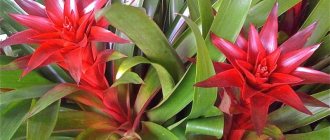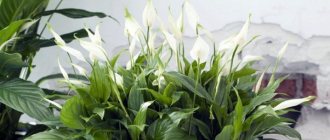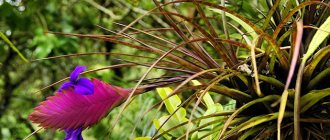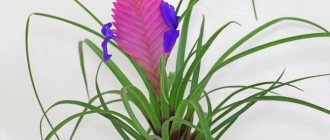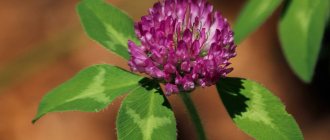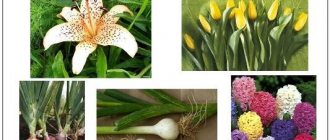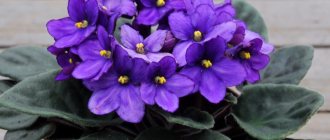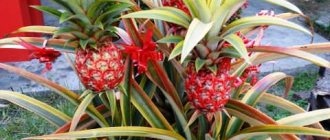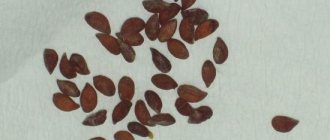Family Bromeliads
The Bromeliad family includes three subfamilies. This:
- Pitcairnioideae;
- tillandsiaceae (Tillandsioideae);
- bromeliads (Bromelioideae), or pineapple.
What does a bromeliad flower look like?
For your information! There are about 3 thousand species and varieties of this herbaceous perennial grass.
Indoor plants from the Bromeliad family: types and features
According to the description, bromeliad has a close relationship with the familiar pineapple, which is quite an edible fruit. And this is no accident, since they are relatives.
All types of crops are of floristic interest. But of these, the most popular are cryptanthus, guzmania, vriesia, indoor pineapple, echmea, neoregelia, billbergia, acanthostachis, neoregelia, nidularium.
Common features of all varieties and types:
- seasonal flowering, that is, in summer;
- the inflorescence is a modified, apical leaf rosette;
- ability to bloom only once. The flower stalk dies, leaving behind a bunch of babies.
For propagation, puppies (kicks) and seeds are used. The first method is used more often.
Note! Flowering can be accelerated by stimulating the flower with ethylene. It is released by fruits, such as apples.
General information about the Bromeliad family
The Bromeliad family includes ground-growing plants and epiphytes. The latter grow by clinging to nearby objects (trees, bushes, stones, buildings, etc.). However, they are not parasites. Nutrition is obtained from air (drops of moisture) and sunlight.
The leaves of the crop are dense and glossy. As they develop, they form a funnel-shaped rosette. The top of the flower changes over time (due to the bract leaves). An inflorescence grows from it (racemose, capitate, paniculate or spicate). The color of the brushes is very bright - all shades of red and yellow.
The flowering period depends on the species and can last from 2-3 weeks to 2-3 months.
Pest protection
If you do not follow the rules for caring for a bromeliad flower, you can expect that at some point it may be affected by serious diseases. Most of them are caused by parasites, which, once on a flower, act to destroy the plant.
Mealybugs and scale insects pose a great danger to bromeliads. The harm of the latter is due to the fact that they feed on the juice that is obtained from the stems and leaves. At the same time, liquid always remains after them, which creates favorable conditions for the development of fungus. No less problems arise when bromeliads are affected by the thyroid glands. To remove these pests, they must be collected by hand. After this, the leaves of the plant need to be treated with a soap solution, and finally sprayed with a tobacco solution.
Moreover, even such treatment does not guarantee that these insects will not subsequently appear on the flower. Therefore, after the measures taken, it is necessary to constantly monitor the condition of the plants. Mealybug control measures involve its collection, which is carried out manually. Next, the plants must be treated with a solution of green soap. The best effect can be achieved only if this operation is carried out with three repetitions. This gives confidence that the bromeliad will not be affected by this pest again in the coming months.
How to care for these plants at home
Tillandsia - home care after purchase, flowering and replanting
Home flower care consists of:
- fertilizing During the growing season it is necessary to fertilize 2 times a month. Complex fertilizers for indoor flowers are suitable. In winter, once every 1.5 months is enough;
- glaze. Given its growth in the tropics, the plant needs to be moistened regularly;
- trimmings. This applies to a faded peduncle;
- transplants. Only if necessary. If the pot has become small.
Important! When planting or replanting, you should take care of drainage.
Temperature, humidity, light
The exotic needs long daylight hours of at least 12 hours a day. Required temperature conditions: summer time - 20-25 ° C, during the rest period - 15-18 ° C. Optimum humidity 70%. Watering is carried out through a tray and regular spraying.
Optimal soil for Bromeliads
The main requirement for soil is looseness and lightness. Soil for Bromeliads can be purchased at the store, or you can prepare it yourself.
A good substrate will come from:
- leaf soil - 2 parts;
- humus and peat - 1 part each;
- river sand - 0.5 parts.
For your information! Enrichment of the base mixture with charcoal, moss, and dry pine needles is welcome.
Bloom
If bromeliad does not bloom for a long time, it can be stimulated.
Ethylene released by ripe fruits will come to the rescue. Place the flower, along with a bunch of bananas, several tomatoes or apples, in a plastic bag and tie it so that the ethylene does not escape. After two days, release the bromeliad, it should help. Once upon a time, the inhabitants of the tropics used cruel measures in an attempt to obtain a good harvest of pineapples, which, as you remember, are close relatives of bromeliads. They were pulled out of the ground and hung upside down. After 3–4 days of torture, the plants were returned to their place. The frightened pineapples released ethylene, and fearing repeated punishment, they began to grow at incredible speed. Unfortunately, bromeliads bloom once in a lifetime. If the bracts turn pale, the end is near. The peduncle dies, and side shoots appear from under the rosette. Don't throw away the faded plant, just remove the dry parts. Let everything remain as it is, the children should grow up and acquire five or six leaves and roots. This will take several months.
It is better to plant young plants in individual pots. Using a sharp knife, cut the sprout from the common root system, sprinkle the wounds with coal and, after drying, plant them in the prepared pot. Be sure to fill the sockets with water when watering and maintain the same conditions. Now you can get rid of the old plant and wait for the young bromeliads to bloom.
You can propagate bromeliads by seeds, which is much more difficult and will take at least three years. If you are not going to start a plantation, this method is not for you. A couple of children are enough, and your temperamental Mexican will bloom again.
Tillandsia - a plant without roots
Tillandsia atmospherica - home care
Tillandsia is a plant without roots. They are needed solely for attachment to neighboring objects.
The plant receives nutrition from moist air. It enters through the trichomes (hair scales) covering the leaf blades.
Epiphyte
Features of caring for atmospheric Bromeliads
It is impossible to grow an epiphyte without effort. It is necessary to create a special microclimate for it - a constant humidity of at least 75%. They do not need a pot with soil, but the roots of the flower must have strong support. These can be stones, tree-like house flowers (only moisture-loving ones).
Important! It is not recommended to leave the roots in water.
Transplanting atmospheric tillandsias
Transplantation as such is not about tillandsia without roots. Unless the support needs to be replaced, for example, the transport bark with a stone.
Variety of atmospheric tillandsia species
There are many types of aerial tillandsia, but the most popular of them are:
- syringoid;
- Gardener's Tillandsia;
- tillandsia bulbosa;
- Tillandsia silver;
- Tillandsia Jellyfish Head;
- tillandsia ruminaceae;
- Tillandsia violetflower;
- Tillandsia protruding;
- tricolor tillandsia;
- Tillandsia Louisiana moss.
Accommodation
The most spectacular way to place bromeliads in your home is with a bromeliad tree. It’s easy to make, the plants on such a tree feel comfortable, and it’s easy to care for them. If you are afraid to immediately take on the unknown, get yourself a couple of young specimens and build a tabletop version of a bromeliad tree.
How to make your own bromeliad tree
- You will need some nice dry driftwood. Before use, it must be treated - washed and dried.
- Then secure the driftwood in a pot or on any stand so that it does not fall or tip over.
- Remove the prepared plants from the pots and wrap their roots with moss. Using mylar thread or polymer-insulated wire, attach the bromeliads to the branches.
- Plant 1-2 plants below, you can decorate pots with plants. You can, after freeing the flowers from the pots, wrap their roots in moss.
- If you add a few more atmospheric tillandsias, as well as orchids, to the composition, it will turn out just like in nature.
Pineapple as an indoor potted plant
Tillandsia Anita - home care
The domestic pineapple (Bromelia Ananas) is an edible crop variety. From the 17th century grown in winter gardens precisely for these purposes.
Homemade pineapple
Two types are in demand for indoor growing:
- crested pineapple (Ananas comosus);
- pineapple bract (Ananas bracteatus).
The fruit is quite large, 30 cm. Full ripening occurs within six months. A ripe pineapple has a yellow peel and light yellow flesh. It tastes sweet with sourness.
Caring for indoor pineapple is easy. To obtain fruits, it is necessary to replant it every two years into a larger pot.
Important! It is better to do the transplanting with gloves on so as not to prick yourself on the thorns.
Temperature, humidity and light
For exotics, the permissible temperature range is from 16–17 °C to 25 °C. A pineapple in a pot at home should be placed in a well-lit place. There should be at least 8 hours of daylight per day. Permissible humidity from 65%.
Watering mode
During the growing season, abundant watering is required, but after the top layer of soil has completely dried. In winter it should be very rare, no more than once a month. Water for irrigation is taken warm, settled. It is advisable to spray regularly, especially in hot weather, since pineapples are grown in warm, humid climates.
Soil and fertilizers
Pineapple grows well in acidic, loose soil. The ideal mixture would be:
- humus - 2 parts;
- turf - 3 parts;
- river sand - 1 part;
- peat - 3 parts.
Any fertilizer for flowering plants is suitable.
Childbirth
- Acanthostachys Klotzsch
- Aechmea Ruiz & Pav. — Ehmeya
- Alcantarea (E.Morren ex Mez) Harms
- Pineapple Mill. - A pineapple
- Andrea Mez
- Androlepis Brongn. ex Houllet
- Araeococcus Brongn.
- Ayensua LBSm.
- Billbergia Thunb. — Bilbergia
- Brewcaria LBSm., Steyerm. & H.Rob.
- Brocchinia Schult.f.
- Bromelia L. - Bromeliad
- Canistropsis (Mez)Leme
- Canistrum E.Morren
- Catopsis Griseb.
- Connellia NEBr.
- Cottendorfia Schult.f.
- Cryptanthus Otto & A. Dietr.
- Deinacanthon Mez
- Deuterocohnia Mez
- Disteganthus Lem.
- Dyckia Schult.f. — Dikkia, or Dikiya
- Edmundoa Leme
- Encholirium Mart. ex Schult.f.
- Fascicularia Mez
- Fernsea Baker
- Fosterella LBSm.
- Glomeropitcairnia Mez
- Greigia Regel
- Guzmania Ruiz & Pav. — Guzmania, or Guzmania
- Hechtia Klotzsch
- Hohenbergia Schult.f.
- Hohenbergiopsis LBSm. &Read
- Lindmania Mez - Lindmania
- Lymania Read
- Mezobromelia LBSm
- Navia Schult.f. — Navia
- Neoglaziovia Mez
- Neoregelia LBSm. — Neoregelia
- Nidularium Lem.
- Ochagavia Phil.
- Orthophytum Beer
- Pepinia Brongn. ex André
- Pitcairnia L'Her.
- Portea K.Koch
- Pseudaechmea LBSm. &Read
- Pseudananas Hassl. ex Harms
- Puya Molina
- Quesnelia Gaudich.
- Racinaea MASpencer & LBSm.
- Ronnbergia E.Morren & Andre
- Steyerbromelia LBSm
- Tillandsia L.
- Vriesia Lindl. — Frizeya, or Vriesia
- Werauhia JRGrant
- Wittrockia Lindm.
Photos of individual species:
Guzmania (guzmania): plant description and flower
What is Guzmania? Bromeliad Guzmania is an epiphytic flower. Like other relatives, it receives root nutrition from the air. The main differences from them:
- colorful bracts. They come in red, orange, yellow, purple;
- A characteristic feature is that after flowering the plant dies.
Guzmania
Description of popular types of Guzmania, adapted for indoor cultivation
For home keeping, they try to choose compact varieties of Guzmania. The most popular of them:
- guzmania reed is a large flower with half-meter leaves. The rosette of the plant is dense. The peduncle is red or orange, the flowers are small white;
- Minor is a hybrid of reed guzmania. The plant is compact and blooms from late winter to early autumn. Its bracts are red, the flowers are white and few;
- hybrid Tempo. It differs from Minor only in size, it is larger;
- hybrids Mix. A lot of them. They differ in the color of the panicles;
- Guzmania Nicaraguan. Compact variety. The rosette consists of long, tightly folded leaves. The spike-shaped inflorescence is light red. The flowers are bright yellow;
- Guzmania Conifera. Large-sized flower with tall red-yellow inflorescence;
- Guzmania Donell-Smith. The inflorescence is dense, paniculate. The flowers are bright yellow. Sepals are bright red;
- single-haired. A very decorative rosette. The long leaves that make it up change shade from light green to green-yellow. The peduncle also changes color from green to red (scarlet, orange). The flowers themselves are white;
- Ostara is a hybrid of the reed guzmania and Guzmania witmackii. Long-flowering epiphyte with burgundy bracts;
- Tricolor. It is distinguished by the beauty of its striped leaves. There are clear white and red stripes on a green background. The flowers are yellow and inconspicuous.
Features of care
Guzmania prefers temperatures from 18°C to 25°C and lacy shade.
Watering is carried out as the soil dries. The water needs to be settled and warm. Spraying is encouraged. Desirable air humidity is 60-85%.
The soil is loose and light. The optimal mixture for orchids will be. A third of the pot’s volume should be filled with drainage material. A ceramic shallow pot will do.
Does not require constant feeding.
Note! Can be fertilized to speed up flowering. Fertilizers for orchids are suitable. The dosage should be reduced by half.
Atmospheric
These bromeliad plants prefer to settle on the spines of huge cacti, at the ends of tree branches, etc. They have a very weak root system, and in some cases the roots are not developed at all. They do not have bright leaves, but the shape of the plants is very diverse. The most common and well-known plants of this group are gray tillandsias. Under natural conditions, they obtain water from drops of dew or fog settling on the leaves. They get their food from dust particles. They should not be watered, but only sprayed with soft water from a spray bottle. Atmospheric bromeliad plants need a lot of light, but diffused. They do not require a special earthen substrate; it is enough to secure them well on a decorative stand.
Cryptanthus: home care
Caring for cryptanthus at home is no different from caring for other bromeliads. For them, the main thing is warmth and humidity. Grows well inside glass flowerpots.
Cryptanthus
For your information! The species is used to decorate florariums and terrariums.
Description of the flower
The main difference is the variety of leaf colors. They come in white, pink, burgundy, and yellow. This species does not have a peduncle. The apical leaves form a star.
Humidity and temperature requirements
The optimal temperature is 18-25 °C, humidity - from 70%.
Kinds
The Plant List database
, the genus includes 61 species:
- Bromelia agavifolia Brongn. ex Houllet
- Bromelia alsodes H.St.John
- Bromelia alta LBSm.
- Bromelia antiacantha Bertol.
- Bromelia araujoi PJBraun, Esteves & Scharf
- Bromelia arenaria Ule
- Bromelia arubaiensis Ibisch & R.Vásquez
- Bromelia auriculata LBSm.
- Bromelia balansae Mez
- Bromelia binotii E.Morren ex Mez
- Bromelia braunii Leme & Esteves
- Bromelia charlesii PJBraun, Esteves & Scharf
- Bromelia chrysantha Jacq.
- Bromelia eitenorum LBSm.
- Bromelia epiphytica LBSm.
- Bromelia estevesii Leme
- Bromelia exigua Mez
- Bromelia flemingii I.Ramírez & Carnevali
- Bromelia fosteriana LBSm.
- Bromelia fragilis LBSm.
- Bromelia glaziovii Mez
- Bromelia goeldiana LBSm.
- Bromelia goyazensis Mez
- Bromelia grandiflora Mez
- Bromelia granvillei LBSm. & Gouda
- Bromelia gurkeniana E.Pereira & Moutinho
- Bromelia hemisphaerica Lam.
- Bromelia hieronymi Mez
- Bromelia horstii Rauh
- Bromelia humilis Jacq.
- Bromelia ignaciana R.Vásquez & Ibisch
- Bromelia interior LBSm.
- Bromelia irwinii LBSm.
- Bromelia karatas L.
- Bromelia laciniosa Mart. ex Schult. & Schult.f.
- Bromelia lagopus Mez
- Bromelia legrellae (E. Morren) Mez
- Bromelia lindevaldae Leme & Esteves
- Bromelia macedoi LBSm.
- Bromelia minima Leme & Esteves
- Bromelia morreniana (Regel) Mez
- Bromelia nidus-puellae (André) André ex Mez
- Bromelia oliveirae LBSm.
- Bromelia palmeri Mez
- Bromelia penguin L.
- Bromelia poeppigii Mez
- Bromelia redoutei (Baker) LBSm.
- Bromelia regnellii Mez
- Bromelia reversacantha Mez
- Bromelia rondoniana LBSm.
- Bromelia scarlatina (Henriq. ex Linden) E.Morren ex CHMorren
- Bromelia serra Griseb.
- Bromelia superba Mez
- Bromelia sylvicola S.Moore
- Bromelia tarapotina Ule
- Bromelia tessmannii Harms
- Bromelia trianae Mez
- Bromelia tubulosa LBSm.
- Bromelia unaensis Leme & Scharf
- Bromelia urbaniana (Mez) LBSm.
- Bromelia villosa Mez
Billbergia drooping
Billbergia drooping is one of the few varieties that does not require light.
Bilbergia
Caring for the plant consists of regular watering, spraying and fertilizing.
Temperature, humidity and light
The species tolerates temperatures of 12 °C well at any time of the year. Grows well on a northern windowsill. To maintain the required humidity, daily spraying will be sufficient.
Watering mode
The next watering is recommended after the soil has dried by 1.5-3 cm. The water should be warm and settled.
Soil and fertilizers
Fertilizing should be complete throughout the year: in the summer every 2 weeks, in the winter once a month. Soil that is acidic (pH = 5) and rough is suitable.
Content temperature
This tropical beauty easily tolerates temperature changes and can easily withstand heat of +38 °C in summer. In winter, a drop to +12 °C is permissible. But still, bromeliads will be more comfortable at any time of the year at +23…+25 °C. Although in winter it is still worth placing an exotic guest in a room with +18 °C.
In summer, do not be afraid to take bromeliads out onto the balcony and even into the garden. Then the plant will be saturated with fresh air, which will have a positive effect on its decorative effect. But choose areas for cultivation in partial shade, protected from wind and rain.
In winter, do not allow the plant to suffer from drafts. But ventilate the room regularly. After all, stagnation of air is detrimental to a flower.
Aechmea flower: home care
Striped echmea (Aechmea fasciata) is a fairly popular variety.
For your information! Each rosette blooms only once.
Conditions for growing at home
This is a convenient flower for home growing. Prefers sunny window sills. To maintain humidity, it is recommended to use a tray with wet expanded clay.
Temperature, humidity and light
The plant needs good lighting. Direct sunlight should be avoided.
The optimal temperature is from 15 ° C to 26 ° C, air humidity is 70-75%.
Watering mode
Watering is required abundantly, without allowing the soil to dry out, and it is better to pour water into a funnel made of leaves.
Soil and fertilizers
A soil mixture of sand, leaf turf, and peat in a ratio of 1:2:1 would be suitable.
You need to feed the flower twice a month with a complex composition for Bromeliads.
Bromeliad de Zapata is a bright representative of the family
De Zapata differs from other varieties of bromeliad only in the shape of its flowers. They resemble shoes on a stalk.
What does care consist of: watering, fertilizing, spraying.
De Zapata
Temperature, humidity and light
Grows well at temperatures from 15 ° C to 25 ° C, humidity about 65%. Need diffused light or partial shade.
Watering mode
Watering is needed after the top layer of soil has completely dried. Regular spraying is encouraged.
Soil and fertilizers
Suitable fertilizers for flowering plants. The soil needs to be loose, rough, and acidic.
Vriesia Astrid: description of the plant and care features
Bromelia Vriesea has about 100 species. They are all tall. Depending on the variety, the color of the leaves can be different (green, striped, purple, crimson).
For your information! At the age of 3-4 years it begins to flower. The spikelet can be monochromatic or multi-colored. The plant dies after flowering.
Vriesia splendor
Vriesea regina is a variety that is distinguished by shiny long leaves. With a peduncle height of 2 m, the leaves grow up to 1 m and longer. The inflorescence is paniculate with light yellow fragrant flowers. The bracts are pink.
Vriesia Splendence
Vriesia Splenriet is the most beautiful representative of the Bromeliads. The funnel-shaped rosette of leaves grows to almost 0.8 m. The leaf plate itself can be cross-striped. Its edges are curved. The peduncle is long, the inflorescence is spike-shaped, large, bright red. Yellow flowers open gradually.
Neoregelia: care at home
Caring for the crop at home is not burdensome. Optimal for it will be diffused light, humidity not lower than 60% and temperature 16-25 ° C. Watering in summer is best carried out at the outlet. It is advisable to water daily, less often in winter and at the root. You can fertilize once a month. A special composition for Bromeliads is suitable.
Neoregelia
Botanical description and natural habitat
In its natural environment, it grows in entire plantations in the tropics of Colombia, Peru, Brazil, and Ecuador. Can grow without soil and on the ground.
The leaves of the crop are wide, long, and have a serrated edge. The central part of the rosette is light. Before the inflorescence appears, the apical rosette becomes burgundy-red. Tassels grow from leaf axils.
Types and varieties for growing at home
The following varieties can be planted indoors:
- Neoregelia carolinae;
- marble neoregelia (Neoregelia marmorata);
- Neoregelia tristis;
- neoregelia beautiful, or elegant (Neoregelia spectabilis);
- Neoregelia pauciflora;
- Neoregelia sarmentosa;
- Neoregelia ampullacea;
- blue neoregelia (Neoregelia cyanea);
- tiger neoregelia (Neoregelia tigrina).
Among the abundance of varieties, you can easily find a plant to your liking. The presentation of the varieties studied to date, presented above in the article, will help with the choice.
Spreading
Plants of the Bromeliad family are native to the tropics of North and South America and Africa. They are common in most tropical and subtropical climate zones of America, from deserts to evergreen moist forests. Under natural conditions, bromeliads settle on the soil, fallen tree trunks and even on stones.
Due to their unusual habitat, all plants have a rather weak root system. Although many species grow on the ground, they obtain their nutrition from the soil, like most plants.
